Understanding design in European ballet schools is crucial for creating spaces that enhance learning and performance. This guide explores key elements such as mirrors, barres, and flooring that contribute to dancer comfort and safety. Discover how thoughtful design elements inspire creativity and ensure a productive environment.
Key Takeaways
- A well-designed ballet school balances aesthetics and functionality, enhancing dancer comfort and performance, which is vital for business success.
- Key design elements, such as mirrors, flooring materials, acoustics, and natural lighting, significantly impact a dancer’s learning experience and safety.
- Incorporating community-focused spaces, modern technology, and flexibility in design promotes inclusivity and enhances the overall ballet education experience.
Essential Elements in Ballet School Design
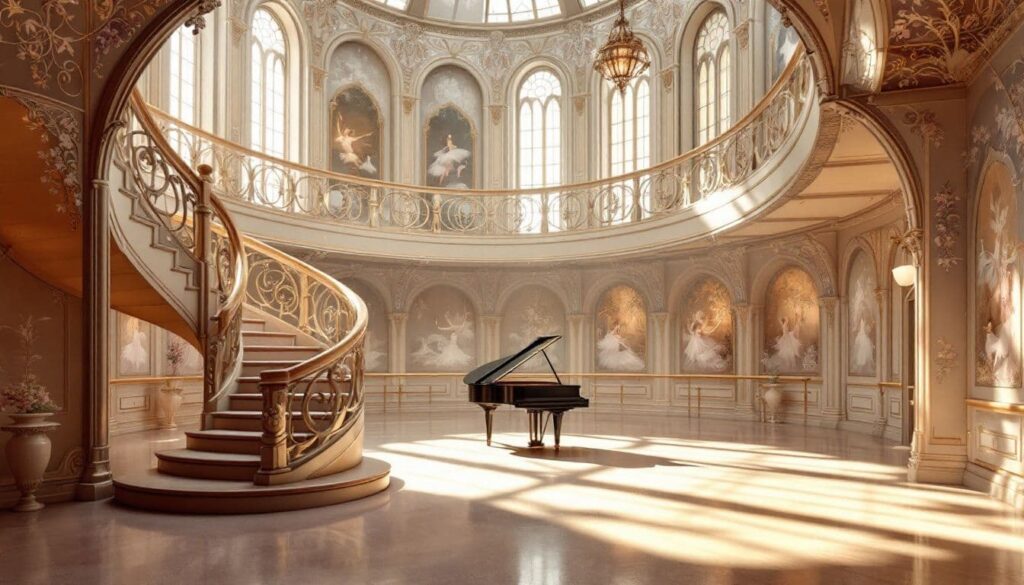
Balancing aesthetics and functionality in ballet school design inspires and uplifts while ensuring classes run smoothly. A well-designed studio is more than just a room; it is a thoughtfully designed space that enhances dancer comfort and performance, making it a key aspect of ballet school success.
Comfort, safety, and inspiration are vital to keep dancers focused and motivated. A thoughtfully designed studio boosts business success by maintaining full classes, ensuring the sustainability of ballet schools.
Mirrors and Barres
Mirrors are a staple in dance studios, transforming them from a simple room into a functional space. These mirrors help dancers see and correct their movements, preventing collisions and building confidence. They provide immediate feedback for on-the-spot technique adjustments, which are crucial to learning.
Adjustable barres are indispensable, allowing dancers of various heights to practice comfortably. These barres are used in daily practice, workshops, and rehearsals, making them versatile additions to any studio.
Mirrors and barres create an environment for dancers to refine their skills precisely and gracefully.
Flooring Materials
The type of flooring in a ballet studio is pivotal to a dancer’s experience. Popular options include sprung dance flooring and hardwood with non-slip sealant. Marley flooring, known for being slip-resistant and gentle on feet, is widely used. These materials enhance performance and play a crucial role in injury prevention.
Wooden sprung floors and marble and vinyl finishes are recommended to reduce injury risk. These floors absorb impact, protecting dancers’ joints during intense movements. Choosing the right flooring is crucial for both performance and dancers’ long-term health and safety. The right flooring materials are essential in transforming a room into a safe and effective dance space.
Acoustics and Sound Systems
Sound quality is crucial in a dance studio’s design. High-quality sound systems ensure clear music, enhancing dancers’ rhythm. Good acoustics ensure that music and instructions are heard clearly throughout the space.
Clarity is vital for daily practice and performances, helping dancers stay in sync and maintain rhythm.
Creating an Inspirational Atmosphere
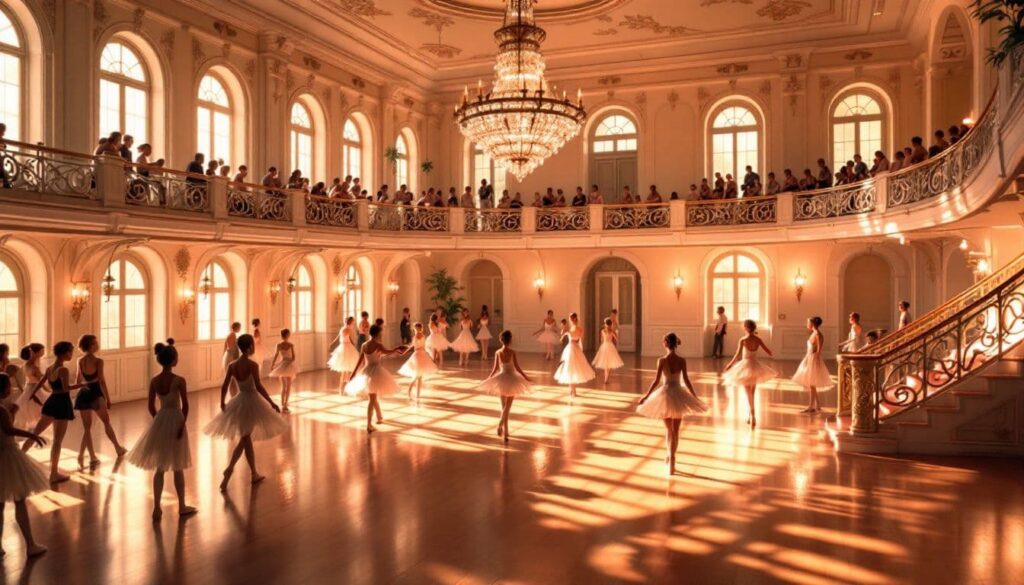
An inspiring and uplifting environment is as crucial as functional elements in a ballet school. The design should stimulate dancers’ emotions and creativity, keeping them motivated and engaged.
Thoughtful design elements transform a room into an inspirational space for dancers. This section will explore how natural lighting, color schemes, and wall art and decor can transform a dance studio into a place that supports and inspires ballet dancers.
Natural Lighting
Natural light enhances mood and well-being in dance studios. Large windows flood the space with light, creating an inviting atmosphere. A studio filled with natural light positively impacts the dance experience, making dancers feel more connected to their environment.
In some studios, a glass ceiling creates an open feel, connecting dancers to the outside world. This connection to nature can inspire, helping dancers feel more relaxed and focused during practice.
Incorporating natural light in the design is a simple yet powerful way to enhance the atmosphere.
Color Schemes
Color choices in ballet studios significantly impact dancers’ emotional experiences. Soft, neutral colors like beige or muted pastels create a calm and focused environment, providing a serene backdrop for concentration. Bolder hues, however, inject energy and excitement into the space for vibrant dance forms.
Deep blues and purples evoke depth and serenity, enhancing the ballet practice environment. Purples promote creativity and passion. Pastels infuse a dance space with a dreamy, graceful aura, improving the overall atmosphere.
When choosing a color palette, designers consider the type of dance taught and the studio’s desired vibe.
Wall Art and Decor
Vibrant and meaningful wall art is pivotal in creating an inspiring atmosphere. Appropriate color schemes for walls can significantly affect mood and focus, enhancing the creative environment. Visual elements such as ballet-themed murals or inspirational quotes inspire students and foster passion.
Thoughtful wall art and decor, whether a simple quote or an elaborate mural, create a motivating space where dancers thrive artistically and emotionally.
Incorporating art that speaks to the heart of dance helps studios nurture creativity and passion.
Safety and Comfort in Ballet Schools
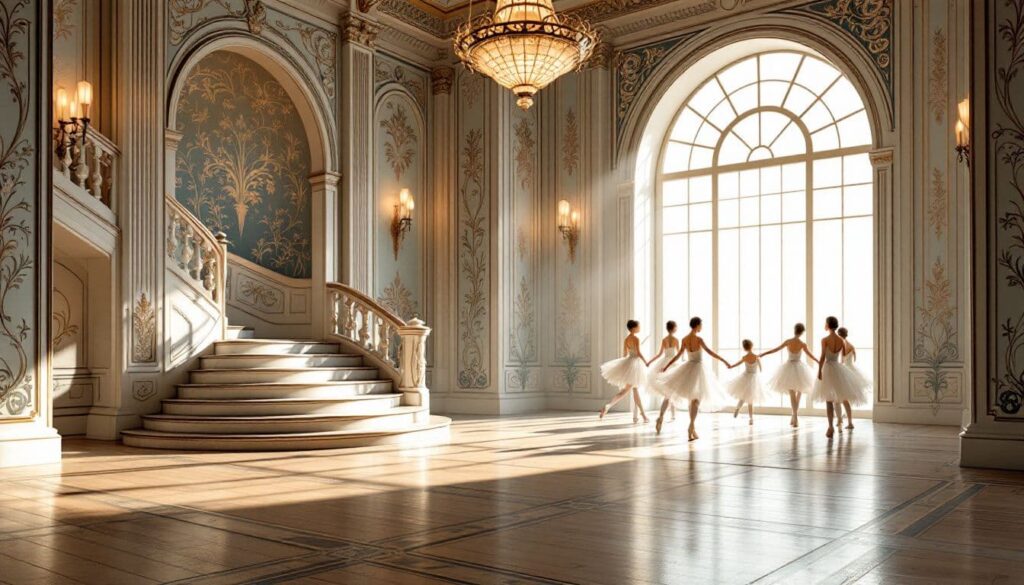
Safety and comfort are paramount in ballet school design. A dance studio should be safe for everyone, from first-time learners to professional dancers. Ensuring safety while nurturing growth and amplifying passion is the main goal of a well-designed dance studio.
This section will cover the importance of climate control, injury prevention, and emergency preparedness in creating a safe and comfortable student environment.
Climate Control
Maintaining a comfortable temperature and air quality in dance studios improves dancers’ performance and health. The optimal temperature range is between 65°F and 75°F (18°C to 24°C) to enhance comfort and prevent injuries.
Proper climate control ensures dancers perform at their best, avoiding risks of overheating or becoming too cold, which can lead to injuries.
Injury Prevention
Dance studios should have impact-absorbing flooring to minimize injury risks. Wooden sprung floors are favored for their impact absorption and safety features.
For injury prevention, it is crucial to have sufficient space for unhindered movement and clear zones around equipment. These measures ensure safe and effective practice and reduce the risk of accidents and injuries.
Emergency Preparedness
Emergency preparedness in ballet schools protects students and staff during unforeseen circumstances. Dance studios should have marked emergency exits for swift and safe evacuation.
Implementing fire safety measures like smoke detectors and fire extinguishers is crucial for safety. Readily available first aid kits ensure prompt treatment of injuries, minimizing complications.
Versatility and Functionality
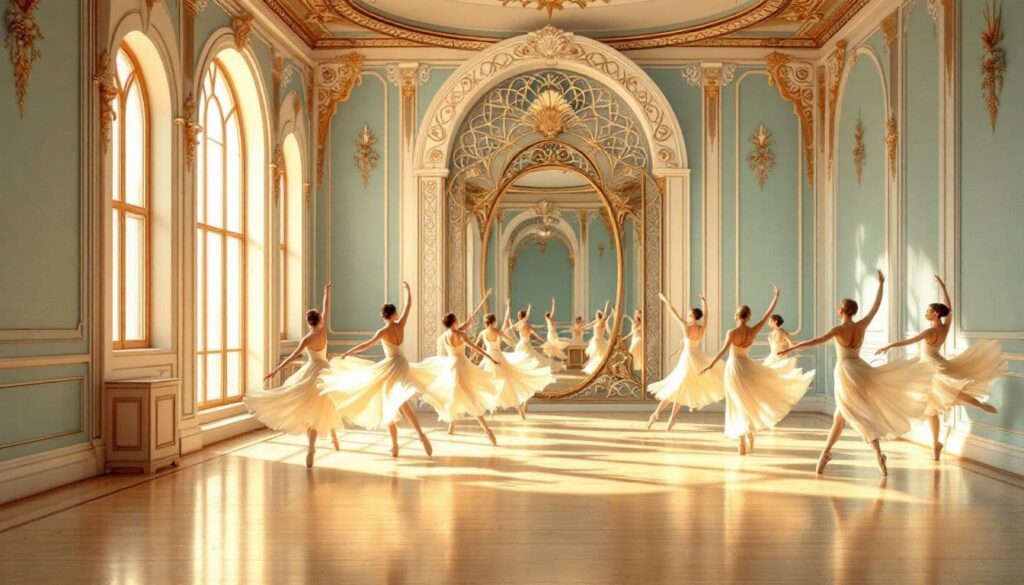
Ballet schools can accommodate multiple dance styles with sprung flooring and adjustable space layouts. Flexible designs that support various dance genres and activities create a dynamic and versatile learning environment.
This section will explore the benefits of multi-purpose rooms and effective storage solutions in enhancing the functionality of ballet schools.
Multi-purpose Rooms
Multi-use rooms are designed to be more than just a room but a versatile space for various activities, hosting classes, workshops, and performances, enhancing the school’s functionality. Multi-purpose studios should include adaptable features for different class formats and workshops. These rooms support a range of activities, catering to various dance styles and needs.
Multipurpose rooms’ flexibility creates a dynamic learning environment, encouraging creativity and participation. Movable equipment like barres and mirrors allows for easy modification for different activities, making them valuable assets to any ballet school.
Storage Solutions
Effective storage solutions like lockers, shelving, and bins are essential for organizing costumes and props and keeping the studio tidy. Lockers or storage spaces for personal items ensure dancers can store their belongings safely and conveniently.
Efficient storage uses clear, stackable bins with labels for easy access and organization. These solutions maintain an organized, clutter-free studio, allowing dancers to focus on their practice.
Modern Technology Integration
Modern technology enhances ballet education by providing innovative tools for learning and teaching. Integrating technology creates a more engaging and effective learning environment for dancers.
This section will discuss the benefits of audio-visual equipment and online class capabilities in modern ballet schools.
Audio-Visual Equipment
High-quality audio systems enhance the learning experience with clear sound for music and instructions. Projectors and screens allow instructors to demonstrate techniques and choreography, improving student understanding visually. Integrating audio-visual equipment enriches the instructional environment and enhances dancers’ learning experiences.
These tools make learning more interactive and visual, helping dancers grasp complex movements and routines more effectively.
Online Class Capabilities
Virtual platforms like Zoom and Google Meet have become standard for offering ballet classes, connecting students with instructors regardless of location. Setting up studios for online classes enables schools to reach students beyond their geographical area.
Virtual ballet classes offer flexible scheduling, accommodating students with varying commitments and making it easier for them to continue their education. This capability ensures that ballet schools remain accessible and adaptable to changing student needs.
Community and Connection
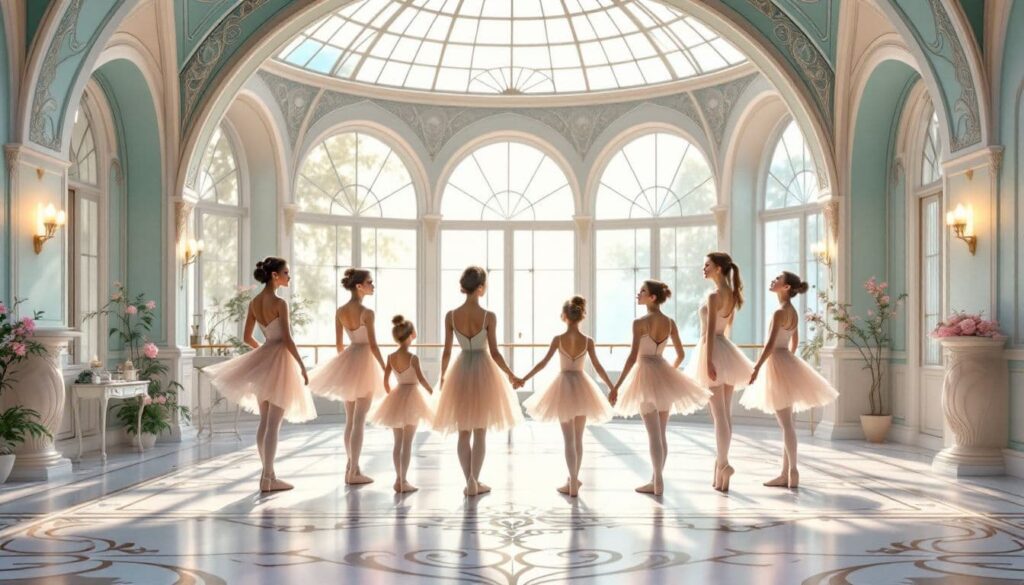
Fostering community in ballet schools creates a welcoming and supportive environment. Comfortable seating in relaxing lounge areas enhances the studio’s ambiance. A small library of dance literature helps foster community. Policies promoting safety and inclusivity for students and staff are crucial.
This section will explore how common areas, performance spaces, and accessibility contribute to building a strong community within ballet schools.
Common Areas
Inviting reception areas with modern aesthetics creates a sense of motion and excitement upon entry. Lounge spaces enhance the welcoming atmosphere for visitors. Integrating art displays in common areas can start conversations and foster connections.
Comfortable seating in common areas makes students and families feel welcome and encourages social interaction. These elements contribute to a sense of community, making the ballet school a place where everyone feels at home.
Performance Spaces
Performance venues should be adaptable for both intimate recitals and larger productions. Flexible venues can facilitate diverse events, from informal showcases to formal productions.
Elegant theaters within dance centers serve performance needs and strengthen the connection between dancers and audiences. Open public lobbies in performance spaces foster community interaction and accessibility. These spaces become the heart of the ballet school, where dancers showcase their hard work and connect with the community.
Accessibility
Incorporating universal design principles ensures ballet schools are welcoming for dancers of all abilities. Key accessibility features include ramps, accessible restrooms, and designated seating areas for individuals with disabilities. These features create an inclusive environment where everyone can participate and enjoy ballet.
By prioritizing accessibility, ballet schools can create an open and inviting space for all community members.
Summary
Designing a ballet school that balances aesthetics, functionality, and inspiration is crucial for creating a space where dancers can thrive. From essential elements like mirrors and barres to modern technology integration and community-focused designs, every detail enhances the dancer’s experience. Ballet schools can create environments that nurture growth and passion by prioritizing safety, comfort, and inclusivity. Whether designing a new studio or renovating an existing one, these tips will help you create a space that supports and inspires ballet dancers at every level.
As we conclude, we remain profoundly grateful for the artdeballet.com partnership. Their unwavering support and dedication to preserving ballet’s legacy have infused this piece with authenticity, and we thank them for helping make it possible.
Frequently Asked Questions
How do you stand out in ballet class?
To stand out in ballet class, wear an outfit that reflects your individuality and engage actively with your peers through quality questions and encouragement. Consistent attendance and personal flair during freestyle moments will also help you shine.
What style of ballet does the Royal Ballet school teach?
The Royal Ballet School teaches the English style of classical ballet through its unique training system, rooted in the techniques initiated by founder Dame Ninette de Valois. This approach focuses on developing both technical skills and artistic expression.
Why are mirrors important in a dance studio?
Mirrors are crucial in a dance studio as they offer dancers immediate feedback, helping them to refine their movements and boost their confidence. This visual tool enhances performance quality and encourages self-awareness.
What type of flooring is best for ballet studios?
The best flooring for ballet studios is sprung dance flooring or Marley flooring, as both provide slip resistance and support for dancers. Hardwood surfaces finished with a non-slip sealant are also suitable options.
How can natural lighting impact a dance studio?
Natural lighting significantly enhances the mood and well-being of dancers, making the studio environment more inviting and uplifting. This positive atmosphere can lead to improved performance and creativity.